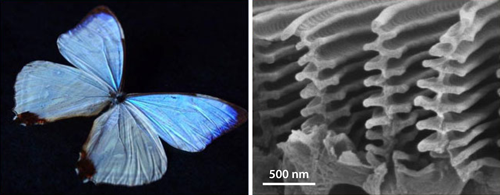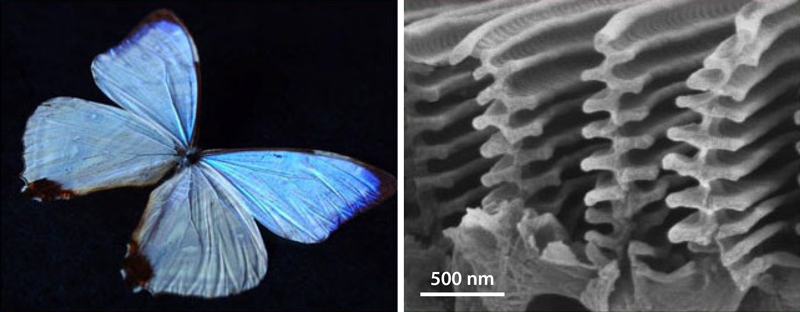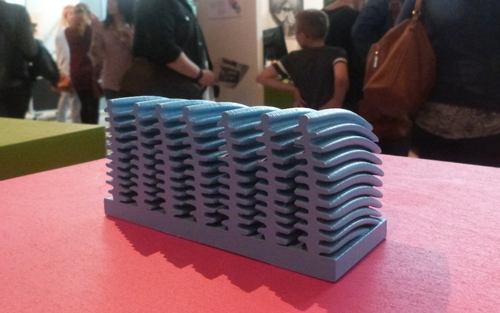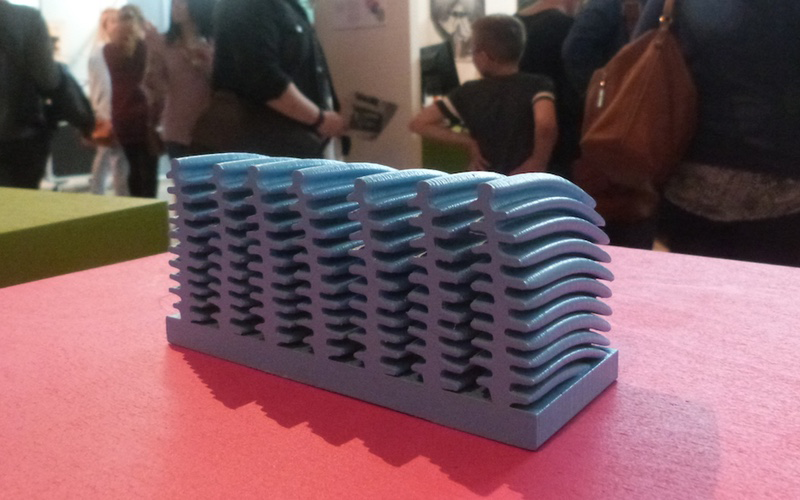Arts & Culture: Going Big with Butterfly Wings
Resting on a leaf, with wings folded, the Morpho butterfly is austere—its underside decorated with circular patterns in earthy brown and yellow hues. In flight, with wings spread wide, the insect exposes its topside, a shimmering swath of metallic blue.
The blue coloration of the Morpho genus of butterfly comes from tiny Christmas-tree-like, chitin and air “sculptures” that adorn the upper side of its wings (see Fig. 1). The branches of the trees have exactly the right spacing between them to strongly reflect blue light. The angle at which light hits these nanoscale structures, or the angle at which the insect is observed, changes the color we perceive the wings to be—the color shifts through various blues before switching to copper when the butterfly is viewed side on. (The brown pigment-produced colors of the wings’ underside, on the other hand, look the same at whichever angle they are observed.) This fluidity in Morpho’s coloration caught the attention of artist Paul Evans, who spent 2016 working with researchers in the Materials Physics group at the University of Sheffield, UK, and learning about the mechanisms by which butterflies, birds, and other creatures get their color from internal structures. Evans, who predominantly paints and draws, was so transfixed by electron micrographs of the nanoscale structures of Morpho’s wings that he used them as the basis for an art installation titled Iridescence.
“The structures are crazy,” said Evans. “[They are] very fine, delicate but robust nanosculptures that are beautifully and remarkably organized.”
Evans first stumbled onto structural color after learning of Vantablack—a material made of aligned carbon nanotubes that absorbs 99.97% of incident visible light. When light hits the material, it gets trapped, bouncing back and forth between the nanotubes in a process that leads to the high absorption. “I got really excited,” said Evans. “The blackest black, what could be more sublime?”
Wanting to know more about why Vantablack is so black and the possibility of using it in his art, Evans contacted Richard Jones, a physicist at the University of Sheffield whose team studies, among other things, color-producing nanoscale structures. The resulting discussions between the two led to an invitation from Jones for Evans to attend seminars and, after a successful funding application, in Evans joining the group for a year-long artist residency. “I find [physics] really quite daunting,” said Evans. “[The residency] has been a fantastic voyage for me.”
Incorporating Vantablack into paintings didn’t pan out for Evans—British sculptor Anish Kapoor bought the exclusive rights to use the material. But Jones and his colleague Andrew Parnell opened Evans’ eyes to the vibrant world of nature’s dazzling hues, like the brilliant white of the Lepidiota stigma beetle, or the rainbow of glittering greens, yellows, and purples of peacock feathers. These natural colors all result from nanoscale patterns and structures.
“[I] could work with a spectrum of superlatives, from the blackest black to the whitest white, without having to [touch] Vantablack,” said Evans. But it was the bluest blue of the Morpho butterfly and its “iridescent coat of many colors” that piqued Evans’ interest most and led to the Iridescence installation.
Iridescence incorporates five 3D-printed sculptures, seated on individual plinths. Each sculpture consists of seven Christmas-tree-shaped plastic forms, each a few centimeters high, lined up in a row. The branches of the trees swoop back in a curve, imitating the shape of the butterfly’s wings, and the trunks of the trees are linked together on a flat base (Fig. 2). The central sculpture is painted the same cerulean blue as Morpho, minus its metallic vibrancy. The other four sculptures are colored ochre, turquoise, powder blue, and a flesh-colored pink, allowing viewers to experience the full range of the butterfly’s iridescent variations as they sweep their head from one end of the installation to the other. “The colors aren’t completely accurate quantitatively, but qualitatively you are seeing the same color change with viewing angle that you see in the butterfly’s wings,” said Parnell.
The sculptures—roughly ten thousand times the size of the real thing—are abstractions illustrating how the structural color phenomenon works in the butterfly. They make the normally invisible, visible, providing a gateway to a world that is normally closed to us, said Parnell. “They are things of beauty.”
Iridescence has been in storage since September 2016, when it was exhibited at Festival of the Mind: Futurecade at the Millennium Gallery in Sheffield. But thanks to a grant from the UK’s Science and Technology Facilities Council, it will soon be appearing in pop-up exhibitions around the UK.
–Katherine Wright
Katherine Wright is a Contributing Editor for Physics.







